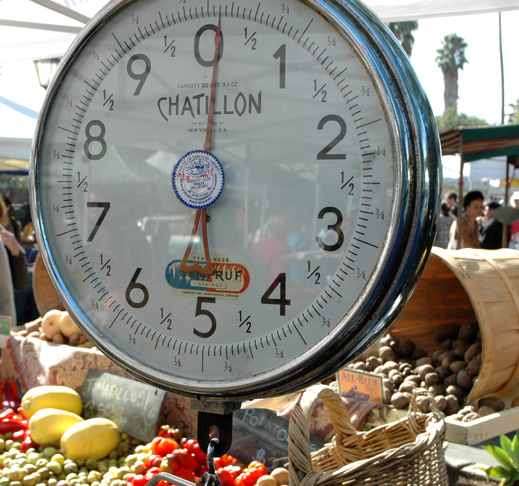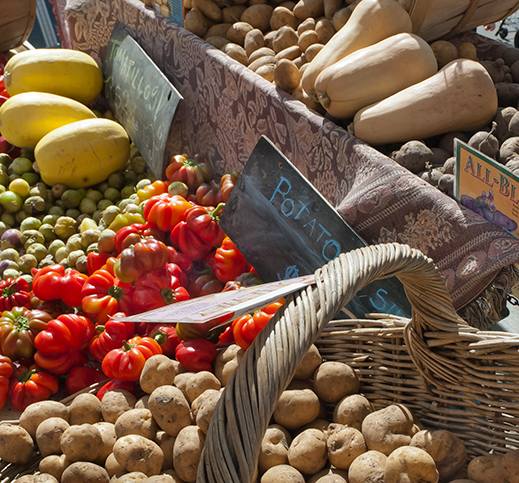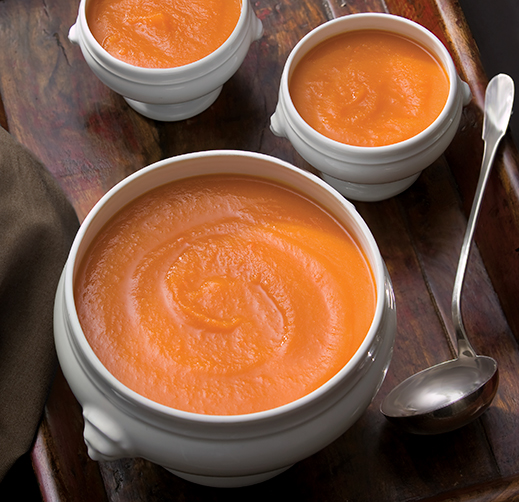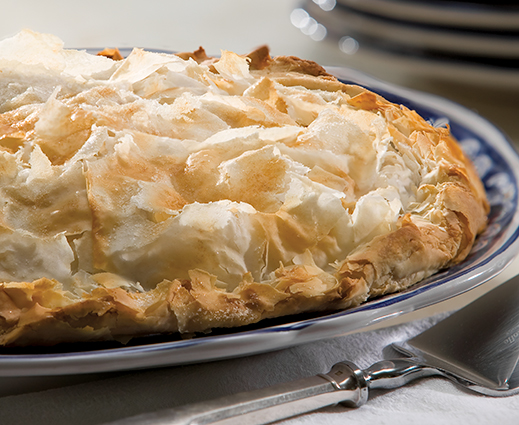
One of my greatest pleasures is discovering a new farmers market wherever I happen to be in the world. Having long meandered through the markets of Provence, savoring local delicacies in sun-dappled squares, it is wonderful to experience the aromas and peculiarities of a new locale. In Venice for example some of the daily markets are set up on floating barges tied up alongside the various canals. You jostle with the locals and chat with the vendors to find the choicest bunch of grapes, fresh figs or local lagoon fish. It is unusual (for us) chaotic, charming and delicious.
Our local markets are no different. If you arrive early in the morning as the fruits, vegetables, flowers and myriad other products are being unloaded you will be witness to a pastoral scene that in some respects has remained unchanged over millennia - Local farmers bringing their seasonal wares to market. Granted the ‘local’ farmers travel further than there horse-driven centuries-old brethren, but the tradition is the same. Over the course of the year, we see the season’s cornucopia of produce as it is unveiled on the market stalls. What better way to mark the passage of time than to anticipate the six weeks of luscious apricots or savor the last of the season’s peaches?
In Europe this is a weekly if not daily ritual, repeated throughout ancient small villages and large cities alike. Many are known for their abundant markets: Aix-en-Provence has daily markets on the Place Richelem, Nice has its Marche aux Fleurs, London’s Borough Street Market is a veritable treasure trove of epicurean delights, and Paris has its sumptuous daily markets dotted throughout its various arrondissements. They provide a common meeting ground where the dishes of the day are discussed with farmers, and purveyors of all the produce are always offering a tip on how best to prepare any given food.
Farmers markets have also been a part of US history but after WWII and the advent of large commercial supermarkets, outdoor farmers markets dwindled. There are a few that have survived. The market in Richmond, VA for instance, opened in 1779, and has remained in operation in one guise or another ever since. The Farmer’s Market in Portland, OR has been in operation since 1768, has moved location at least six times in its 242-year history and survived, but these are the exceptions.
Indeed in California it was illegal (for a period of time) to sell produce outside of a commercial market. The law – that controlled amongst other things, how food was sorted, packed and transported for sale - remained in place until the late 1970’s. In 1977 farmers faced with a huge surplus of peaches forced the hand of this legislation by dumping rotting fruit on the lawn of the state capitol. Then Governor, Jerry Brown compromised, and the law was modified to allow the sale of produce in farmers markets.
Although there have been a handful of long running farmers markets in California, notably the market at Fairfax and 3rd in Los Angeles, which has been in operation since 1934, long standing open farmer’s markets have been limited in this state.
This has radically changed over the last three decades. In 1979 there were only 12 certified farmer’s markets in California. There are 540 today – more than in any other state in the nation - and over six thousand in the US. There has also been a 16 % increase in farmers markets since last year alone, interestingly, mostly in the central, farm-belt part of the country.

As Michael Pollan, author of The Omnivores Dilemma said “Going to the farmer’s market, meeting farmers and learning what to do with an unfamiliar vegetable, is one of the most pleasurable things I do every week—infinitely more stimulating than going to the supermarket.”
As consumers become more aware of their food sources and question the practices of large commercial farms, the demand for locally grown, healthy, organic produce has risen steadily over the past decade.
A fact that is born out here in Santa Barbara, as our own Farmers Markets have steadily grown over the past 27 years. The Santa Barbara Certified Farmers Market was formed in 1983 and now has venues every day of the week but Monday. There were open markets before in Santa Barbara, notably during WWII. In 1943 local Victory gardeners and local farmers argued with the Santa Barbara Home Food Production Committee that their surplus produce would be plowed under unless they were given the opportunity to sell it to the local population. A month of negotiations followed when the local city council announced that the first farmers market would take place on Wednesday July 7th 1943 in the 700 block of Anacapa Street. Although the first market was not a success, local support was enthusiastic and so the market was given a second try. A newspaper article from July 10th 1943 reported “Not since the days of the famed Old Spanish Days Fiesta has Santa Barbara seen the equal of the festive gaiety that attended the Farmers’ Market here today. That was the opinion of hundreds of shoppers who came to buy and returned with shopping bags and baskets heaped with dewy-fresh vegetables and fruit right out of the gardens and groves of the area” A comment that would be apt today.
Despite the fact that the population of the United States now spends less of their disposable income on food than at any other time in its history and less than any other people on earth – less than ten percent – it is heartening and encouraging to see that farmers markets are flourishing.
Wendell Berry once wrote “Eating is an agricultural act”. As you walk down State Street on a Tuesday afternoon, serenaded by the sounds of the market, entertained with the voices of street musicians and caressed with ocean breezes as they drift up the white tented thoroughfare, you are an active participant in that very special act.

ROASTED BUTTERNUT SQUASH AND PUMPKIN SOUP
I adore this soup. The aroma when the butternut squash and pumpkin are roasting is sweet and tantalizing. The color is beautiful and the taste is rich, unctuous and evocative of everything to do with the flavors of the season.
Serves 6 – 8 people
1 medium butternut squash - halved and seeded
1 small pumpkin – halved and seeded
3 tablespoons unsalted butter
1 large onion - thinly sliced
5 cups vegetable stock
Salt and pepper
Origins: Butternut squash is a type of winter squash. Sweet and nutty in flavor it is similar to a pumpkin. Its orange colored pulp becomes more pronounced as it ripens. It originated in Mexico. The ancient Indians called it ‘The apple of God’ as the seeds were believed to increase fertility. It was one of the first foods cultivated by Native Americans and the Inca. It was only introduced to Europe during the 16th century.
ROASTED HEALTHY FAMILY FARMS CHICKEN
Serves 8 people
4 large sprigs rosemary – leaves removed
4 sprigs thyme – leaves removed
1 bunch chives – finely chopped
1 small bunch parsley – finely chopped
4 spring onions – finely chopped
Zest of 1 lemon – quarter the zested lemon and set aside
3 cloves garlic – peeled and minced
1 tablespoon olive oil
Salt and pepper
2 organic chickens
TOMATO CRUMBLE
Serves 8 people
16 medium sized tomatoes – cut in half cross-wise
olive oil
fresh thyme and rosemary – a few sprigs of each, stems removed and coarsely chopped
salt and pepper
4 oz flour
3 oz bread crumbs
3 oz grated parmesan
4 oz butter – cut into small pieces
2 oz pine nuts
6 oz soft goat cheese
2 Tablespoons yogurt
2 tablespoons crème fraiche

GOLDEN PHYLLO APPLE AND PEAR PIE
I delight in dishes with phyllo dough and have long been inspired by Greek food. When I lived in Los Angeles, I spent many a Sunday lunch at a Greek restaurant owned by my lovely friend Sofi, savoring the dishes of the Aegean. She made heavenly puddings such as ‘glactoboureko’ and ‘bougatsa’. I was hooked and as I started to explore the dishes of the islands I came across an apple pie called ‘milopita’. From the traditional base I made this version that has three or four varieties of apples in it – the addition of pears is also delicious, and true my Gallic origins I also added in some Grand Marnier. It is an ideal dessert to end up sitting in front of a log fire with and then perhaps an afternoon snooze.
Serves 8 people
8-10 apples of at least 3 or 4 different varieties – peeled, cored and thinly sliced (If you are using pears as well then reduce the number of apples accordingly)
1 teaspoon ground cinnamon
½ teaspoon allspice
¼ teaspoon clove powder
1 package phyllo dough – thawed
4 oz butter
1 cup sugar
Grand Marnier
Note: This is very good served with vanilla ice cream!